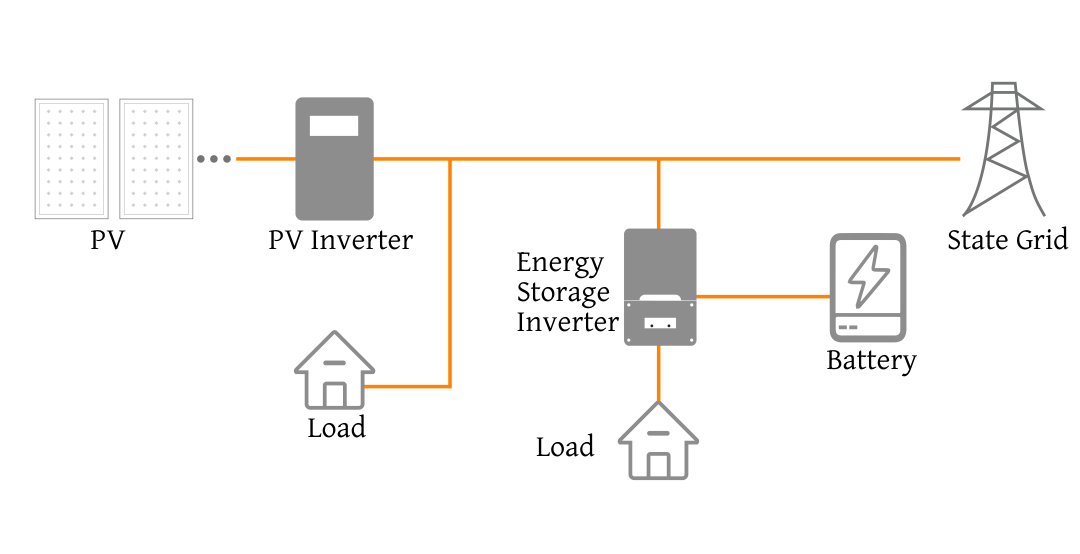Energy storage technology refers to the process of storing energy through media or equipment and releasing it when needed; photovoltaic + energy storage combines solar photovoltaic power generation with energy storage technology to store the electric energy generated by the photovoltaic system so that it can be used when needed. Ensure stable power supply when needed. Currently, the system solutions for photovoltaic + energy storage on the market mainly include DC coupling and AC coupling. So what is the difference between these two solutions?
The difference between DC coupling and AC coupling
DC coupling means that energy storage cells and photovoltaic modules are connected to the DC side of the integrated photovoltaic and storage machine. The integrated photovoltaic and storage machine is directly connected to the photovoltaic modules, and the energy collection point is on the DC side.

AC coupling means that the energy storage system and the photovoltaic system are connected on the AC side. , the energy storage system (battery, energy storage inverter) and the photovoltaic system (photovoltaic modules, photovoltaic inverter) work independently of each other, and the energy collection point is on the AC side. However, due to differences in circuit structures and electrical equipment between the two, there are also major differences in working principles, flexibility, efficiency, etc.

1. Differences in working principles
DC coupling: In this solution, the photovoltaic inverter and the bidirectional converter are integrated into a photovoltaic and storage integrated machine, and are directly connected to the photovoltaic modules, power grid, battery, etc. to form a whole. When the photovoltaic system is running, the electricity generated can charge the battery through the photovoltaic storage integrated machine, supply power to the load, or be input into the power grid.
AC coupling: This solution includes two parts: photovoltaic system and energy storage system. The photovoltaic system consists of photovoltaic arrays and photovoltaic inverters; the energy storage system consists of energy storage inverters and batteries. The two systems can operate independently without interfering with each other, or they can be separated from the power grid to form a micro-grid system. When the photovoltaic system is running, the generated power can be used to power the load through the photovoltaic inverter or be input into the grid, or it can be used to charge the battery through the energy storage inverter.
2. Flexibility Differences
DC coupling: In this solution, photovoltaic modules, photovoltaic storage integrated machines and batteries are in a serial state and are closely connected to each other. The addition and removal of equipment is complicated and the flexibility is average. It is mainly used in new photovoltaic markets, such as newly installed Photovoltaic storage systems, photovoltaic modules, integrated photovoltaic storage machines and batteries need to be designed according to the user's load power and power consumption.
AC coupling: In this solution, the photovoltaic inverter, energy storage inverter and battery are in parallel state. The connection is flexible and it is more convenient to add or remove equipment. It can be applied to photovoltaic stock and new markets. If a new energy storage system is added to the original photovoltaic system, it can be directly incorporated into the equipment for use without additional system design adjustments. In addition, the design of the energy storage system is not directly related to the photovoltaic system in principle and can be determined according to needs.
3. Photovoltaic utilization rate differences
From the perspective of photovoltaic utilization efficiency, the two solutions have their own characteristics: In the DC coupling system, the photovoltaic modules store electric energy into the battery through the controller, and the efficiency can reach more than 95%. The electric energy can be stored for night use. This solution is more It is suitable for situations where the electricity consumption during the day is less than the electricity consumption at night; in the AC coupling system, the photovoltaic modules directly supply power to the load through the photovoltaic inverter, and the efficiency can reach more than 96%. This solution is more suitable for the situation when the electricity consumption during the day is greater than Electricity usage at night.
To sum up, the characteristics and selection of DC coupling and AC coupling are not absolute, and more considerations need to be made based on actual application requirements.
